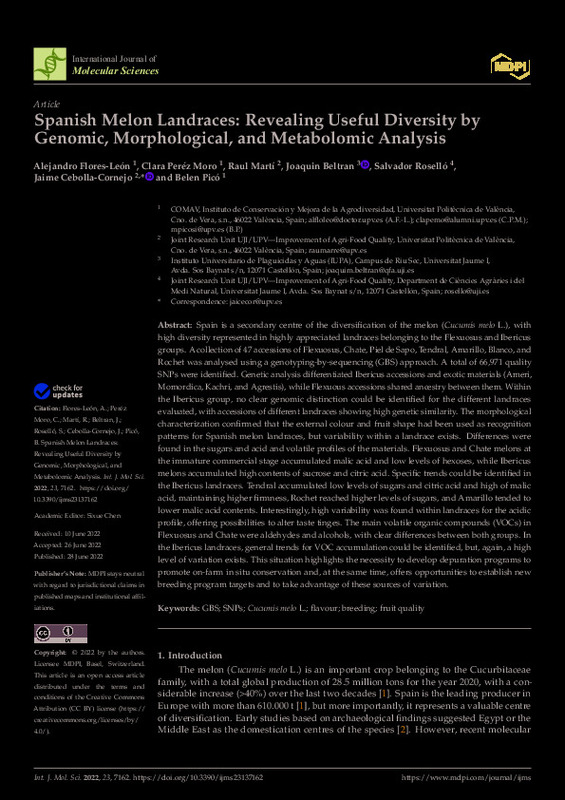|
Resumen:
|
[EN] Spain is a secondary centre of the diversification of the melon (Cucumis melo L.), with high diversity represented in highly appreciated landraces belonging to the Flexuosus and Ibericus groups. A collection of 47 ...[+]
[EN] Spain is a secondary centre of the diversification of the melon (Cucumis melo L.), with high diversity represented in highly appreciated landraces belonging to the Flexuosus and Ibericus groups. A collection of 47 accessions of Flexuosus, Chate, Piel de Sapo, Tendral, Amarillo, Blanco, and Rochet was analysed using a genotyping-by-sequencing (GBS) approach. A total of 66,971 quality SNPs were identified. Genetic analysis differentiated Ibericus accessions and exotic materials (Ameri, Momordica, Kachri, and Agrestis), while Flexuous accessions shared ancestry between them. Within the Ibericus group, no clear genomic distinction could be identified for the different landraces evaluated, with accessions of different landraces showing high genetic similarity. The morphological characterization confirmed that the external colour and fruit shape had been used as recognition patterns for Spanish melon landraces, but variability within a landrace exists. Differences were found in the sugars and acid and volatile profiles of the materials. Flexuosus and Chate melons at the immature commercial stage accumulated malic acid and low levels of hexoses, while Ibericus melons accumulated high contents of sucrose and citric acid. Specific trends could be identified in the Ibericus landraces. Tendral accumulated low levels of sugars and citric acid and high of malic acid, maintaining higher firmness, Rochet reached higher levels of sugars, and Amarillo tended to lower malic acid contents. Interestingly, high variability was found within landraces for the acidic profile, offering possibilities to alter taste tinges. The main volatile organic compounds (VOCs) in Flexuosus and Chate were aldehydes and alcohols, with clear differences between both groups. In the Ibericus landraces, general trends for VOC accumulation could be identified, but, again, a high level of variation exists. This situation highlights the necessity to develop depuration programs to promote on-farm in situ conservation and, at the same time, offers opportunities to establish new breeding program targets and to take advantage of these sources of variation.
[-]
|
|
Agradecimientos:
|
This work was supported by grants PROMETEO/2017/078 and PROMETEO/2021/072 (to promote excellence groups), funded by Conselleria d'Educacio, Investigacio, Cultura i Esports (Generalitat Valenciana, Spain) and grant ...[+]
This work was supported by grants PROMETEO/2017/078 and PROMETEO/2021/072 (to promote excellence groups), funded by Conselleria d'Educacio, Investigacio, Cultura i Esports (Generalitat Valenciana, Spain) and grant AGL2017-85563-C2-1-R-AR, funded by AEI 10.13039/501100011033 and by "ERDF: A way of making Europe". C.P.M. is a recipient of the predoctoral fellowship "Programa de Ayudas de Investigacion y Desarrollo (PAID-01-19)" from Universitat Politecnica de Valencia, R.M. is a recipient of a postdoctoral grant (PAID-10-20) from Universitat Politecnica de Valencia, and A.F.-L. is a recipient of a predoctoral fellowship from Generalitat Valenciana.
[-]
|









